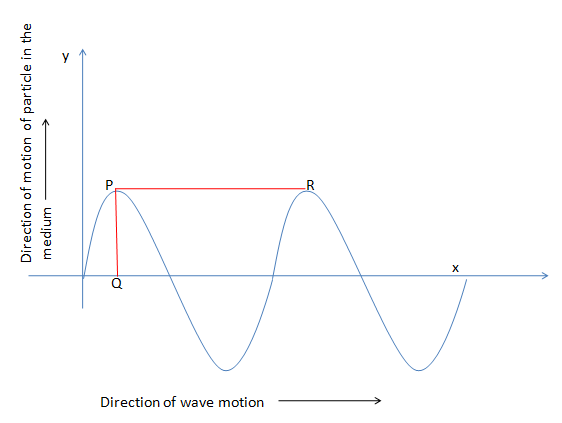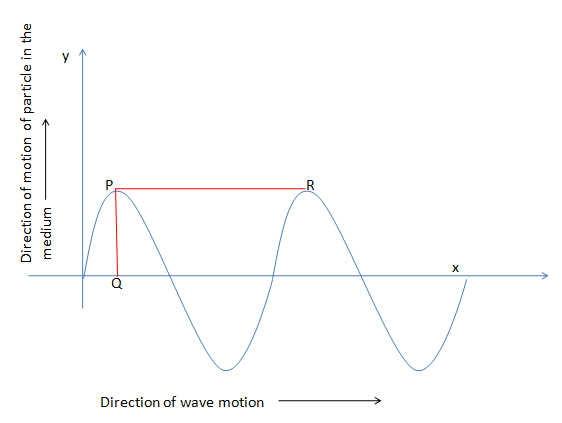Answer
363.3k+ views
Hint: The points of a transverse wave oscillate along the perpendicular path which shows the direction of the wave motion. This wave can be represented through a sine or cosine curve.
The amplitude of the wave is the highest displacement of the wave from its initial position and the wavelength can be measured from the length of the two consecutive highest picks of that wave.
Complete step by step answer:

• The diagram is showing that a wave is moving towards the horizontal direction i.e $x - axis$ and each particle of the wave is moving towards the vertical direction i.e $y - axis$. Hence the motion of the wave and the motion of the particles is perpendicular to each other. So it is a transverse wave. Since the wave starts from the main point or the $0$ state, it describes a Sine wave.
• In the diagram $PQ$ is the amplitude. The amplitude of a wave can be defined as the highest displacement of the wave from its initial position.
• In the diagram $PR$ is the wavelength of the wave. Wavelength is the length of a complete wave or we can say the distance between two consecutive same phased particles on the wave, is called the wavelength.
• Generally, we can also include that the length of the two consecutive highest picks of that wave is called the wavelength. Hence here in the diagram, the mentioned line $PR$ is the wavelength as it is showing the distance between two consecutive
Note: The transverse wave can be represented by sine or cosine function as harmonic function. So we may write the equation of motion of a wave, $y = a\sin \omega t$ and $y = a\cos \omega t$
Where, $y$ is the position of a particle on the wave at time $t$ , $\omega $ is the angular frequency and, $a$ is the amplitude.
Also the equation can be represented, $y = a\sin \omega \left( {t + \dfrac{x}{V}} \right)$ and $y = a\cos \omega \left( {t + \dfrac{x}{V}} \right)$
$x$ is the displacement and $V$ is the velocity of the wave.
The amplitude of the wave is the highest displacement of the wave from its initial position and the wavelength can be measured from the length of the two consecutive highest picks of that wave.
Complete step by step answer:

• The diagram is showing that a wave is moving towards the horizontal direction i.e $x - axis$ and each particle of the wave is moving towards the vertical direction i.e $y - axis$. Hence the motion of the wave and the motion of the particles is perpendicular to each other. So it is a transverse wave. Since the wave starts from the main point or the $0$ state, it describes a Sine wave.
• In the diagram $PQ$ is the amplitude. The amplitude of a wave can be defined as the highest displacement of the wave from its initial position.
• In the diagram $PR$ is the wavelength of the wave. Wavelength is the length of a complete wave or we can say the distance between two consecutive same phased particles on the wave, is called the wavelength.
• Generally, we can also include that the length of the two consecutive highest picks of that wave is called the wavelength. Hence here in the diagram, the mentioned line $PR$ is the wavelength as it is showing the distance between two consecutive
Note: The transverse wave can be represented by sine or cosine function as harmonic function. So we may write the equation of motion of a wave, $y = a\sin \omega t$ and $y = a\cos \omega t$
Where, $y$ is the position of a particle on the wave at time $t$ , $\omega $ is the angular frequency and, $a$ is the amplitude.
Also the equation can be represented, $y = a\sin \omega \left( {t + \dfrac{x}{V}} \right)$ and $y = a\cos \omega \left( {t + \dfrac{x}{V}} \right)$
$x$ is the displacement and $V$ is the velocity of the wave.
Recently Updated Pages
Basicity of sulphurous acid and sulphuric acid are

Assertion The resistivity of a semiconductor increases class 13 physics CBSE

Three beakers labelled as A B and C each containing 25 mL of water were taken A small amount of NaOH anhydrous CuSO4 and NaCl were added to the beakers A B and C respectively It was observed that there was an increase in the temperature of the solutions contained in beakers A and B whereas in case of beaker C the temperature of the solution falls Which one of the following statements isarecorrect i In beakers A and B exothermic process has occurred ii In beakers A and B endothermic process has occurred iii In beaker C exothermic process has occurred iv In beaker C endothermic process has occurred

The branch of science which deals with nature and natural class 10 physics CBSE

What is the stopping potential when the metal with class 12 physics JEE_Main

The momentum of a photon is 2 times 10 16gm cmsec Its class 12 physics JEE_Main

Trending doubts
Difference Between Plant Cell and Animal Cell

Difference between Prokaryotic cell and Eukaryotic class 11 biology CBSE

Fill the blanks with the suitable prepositions 1 The class 9 english CBSE

Change the following sentences into negative and interrogative class 10 english CBSE

Fill the blanks with proper collective nouns 1 A of class 10 english CBSE

Give 10 examples for herbs , shrubs , climbers , creepers

What organs are located on the left side of your body class 11 biology CBSE

Name 10 Living and Non living things class 9 biology CBSE

What is the z value for a 90 95 and 99 percent confidence class 11 maths CBSE




